In the first years of the 20th century, the US military was looking for a new standard sidearm in a .45-caliber cartridge, and set up a series of trials to choose one. The entrants to the 1907 pistol trials included many of the prominent semiauto pistols of the day, like the Parabellum (aka Luger), John Browning’s design that would become the Model 1911, the Bergmann-Bayard, and the Webley-Fosbery. Among these submissions was a design from the Savage Arms Company; basically a version of their .32ACP model 1907 pistol scaled up to .45ACP.
In the initial testing, the Savage did fairly well, although it did suffer a few dozen various malfunctions over the course of 913 rounds. It was recommended for further field trials by the testing board, along with the Colt/Browning pistol. The result of these extended trials was the selection of the Colt/Browning, as it proved a more durable and reliable design than the Savage.
Having now had the opportunity to fire the Savage, I could concur with the Army decision to choose the Colt over the Savage. The Savage is a decent pistol, but inferior to the Colt 1911 in a number of ways. It has more felt recoil, it is physically larger and bulkier,and its controls are more difficult to operate. Granted, many of these things could be fixed with further refinement (as has been done with the 1911 in 106 years since the trials). As it stood in 1907, the Savage had a surprisingly stiff trigger and tiny sights, which made it difficult to shoot accurately. The magazine release was a bit awkward to use, and the slide lock was both very small and not conveniently positioned. The grip was generally good, although designed at too close to a right angle to the bore (a bit like holding a TT33 Tokarev).
Mechanics
Mechanically, the Savage is a locked action using a rotating barrel and recoil operation. However, the dwell time during which the action remains locked is very brief. As soon as the slide begins to move rearward, the barrel rotates and opens – in most other rotating barrel designs there is a bit of rearward locked travel allowed, so that pressure can drop before the breech opens. The Savage does not incorporate this. Instead, the barrel turns counter-clockwise to unlock, and the rifling spins the bullet in a clockwise direction. This causes the bullet to exert a force on the barrel clockwise, presumably preventing it from rotating until the bullet has left the muzzle. This does seem to work in practice, as still frames from the video show muzzle flash (indicating the bullet has left) while the cocking piece remains forward:
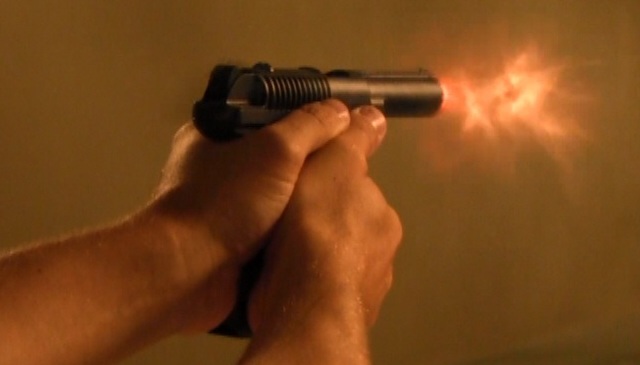
However, the unlocking does occur faster than in other locked-breech handguns. When looking at the frame-by-frame shooting footage, I was treated to this impressive display of flash emanating from every opening of the gun as it cycled. If the action stayed closed a bit longer, this unburned powder would presumably have blown out the muzzle instead of the breech…
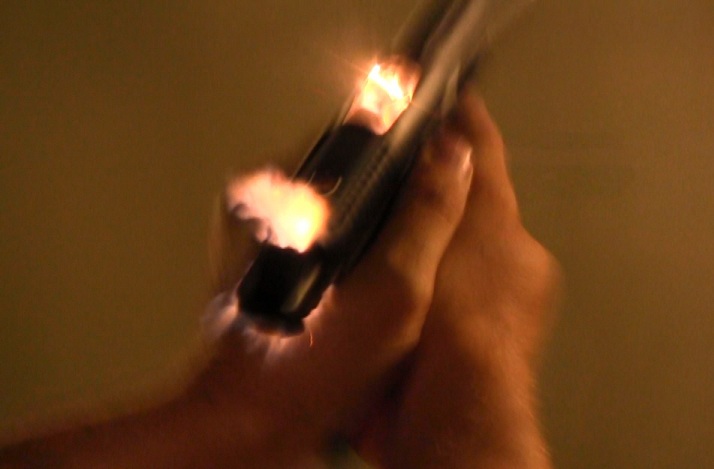
After the Trials
Over the course of the field trial, many of the Savage pistols were returned to the company for repair, and at the end of the period they were all factory refurbished. The guns were later sold back to Savage as surplus (for $6 each, compared to the original price of $65), since the design had not been adopted. Happily, this allowed them into the civilian market – which is why they can still be found today.
Photos
[nggallery id=197]

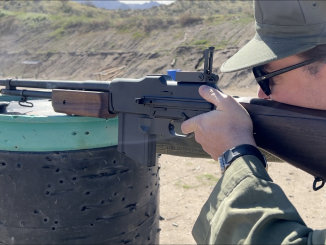
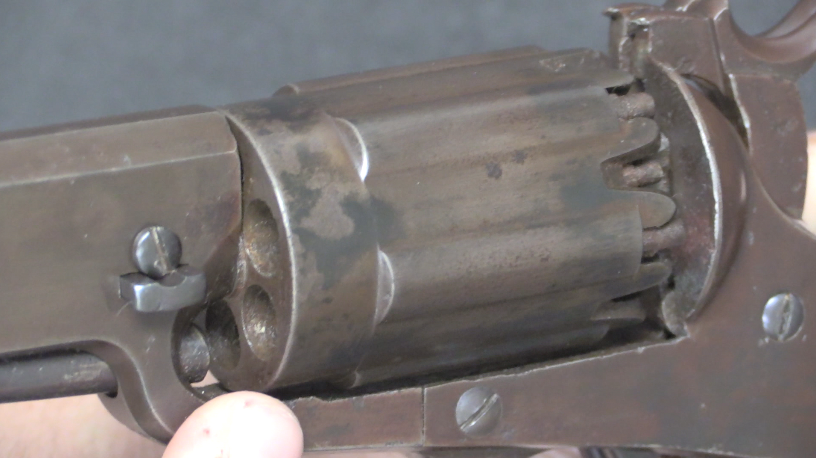
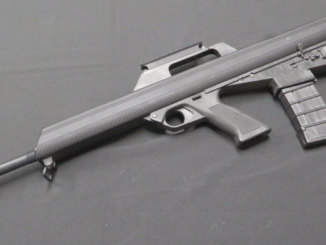
Handguns locked by a rotating barrel restrained by bullet spin torque seem to operate much more quickly than Browning style handguns. The MAB PA-15 is probably the quickest reloading handgun ever made. The rotating barrel lock is released the very moment the bullet exits the barrel.
Breech flash isn’t really a good indicator or breech pressures on opening. Measure the spent cartridge base diameters and you will probably not find much expansion. I have always found my Savage Model 1917 cases to have normal expansion. I think that breech flash is more a function of propellant chemistry.
Savage’s sales slogan for their auto pistols was “10 Shots Quick”. Very appropriate for the fast cycling pocket autos.
As usual, great job done FWs, thumbs up!
For interest sake I looked at several rotary action pistols with objective to review the sense of rotation. Here are several specimen incl. last entry:
Savage – RH/nR (nR = no recoiling barrel)
MAB P-15 – RH/nR (very similar to Savage)
Steyer-Mannlicher 1912 – RH/R
CZ24 – RH/R (based on Mauser)
Obregon – LH/R (reviewed by FWs)
Beretta (Stoeger) Cougar – LH/R
We can conclude couple of things out of this. One is that with non-recoiling barrels (only two with almost identical action) they are RH rotating. If we take “equal&opposite” theorem into count, it seem to add up; barrels are forced to turn AGAINST its natural tendency, therefore adding to breech-open delay.
For the rest and more conventional barrel recoiling designs it probably does not matter much which direction they turn, since this is probably not the determining factor when comes to mentioned delay.
Here is info on MAB P-15 (French made gun in second half of 20th century); first large capacity handgun – http://www.waltherforums.com/forum/free-range-time/16691-mab-pa-15-9para.html
When you look closely at the actuating lug (on top of barrel) you seen slant cut at front left tip of it (it seem to have smaller angle to axis of barrel than with Savage). Since this engages linearly moving slide, there is only one possible outcome – RH turn.
Props for adding the blooper, and not editing out all your mistakes 😀
muzzle flash at the front and back of the pistol , did not know that was possible
One item I wanted to mention and missed is the splendid appearance of sample pistol. Both the workmanship and finish – considering the age (and even if it was made recently) it looks gorgeous. On balance though, in amount of material/ visible strength it just does not stand comparison with Gov’t Mod.1911.
I wonder if Savage has made since 1930s, or plans to make pistols of this system in lesser calibers; or other maker under license. This would be quite nice edition to existing offer.
I agree both on the condition of the sample and the alluring aesthetics, which are of course a by-product of that somewhat inefficient design. It’s a hell of a firebreather though and all of that combined makes it a really cool piece to look at.
It definitely is one to feed thoughts of alternate dimensions, where the Savage was adopted and modified over a century instead of the Browning. Well, I guess that could be asked of all things Browning 🙂
Neat, one of the pistols I frequently keep an eye out for.
I’ve always been more interested in the scaled up Remington 51 that Pederson entered into the competition.
FWIW, the Remington was pitched to the military in 1917, and the .380 version wasn’t patented until 1915. The design wasn’t around in time to be submitted to the 1907 trials. I would love to get my hands on one of the .45 ACP Remington 53s, though…
Any idea whether the inter war .40cal BSA auto pistol was one of the Pederson designs?
I’ve never found any technical info on it – it has the look and the historical timing of one of Pederson’s.
I wish Remington had put the Model 53 into production. But unfortunately there just wasn’t a market for it at the time in the absence of military sales.
Ian wasn’t kidding when he mentioned that the sights were somewhat tiny — perhaps “miniscule” would be an appropriate description. Why did Savage choose to go with such physically small sights? As far as I can tell, there was plenty of room for larger and more user-friendly sights.
The sights on the .32 Savage are the same. Use them for a while and you will understand the popularity of point shooting during that time period.
There were sights? When I shot the pistol I could not see any sights
How is it that the trials were in .45acp? That is, had the military already accepted that cartridge? If so, what weapons had they tested it with, and against what other .45 contenders?
The trials were done with an early version of the .45 cartridge, designated the M1906. It used a case 1mm shorter than the eventual (and still current) .45 ACP, although the Savage pistols were rechambered by Savage for the updated cartridge before being sold to the public. However, and of the other trials guns (like the .45 Luger, for example) should have a chamber slightly too short for modern ammo.
Very much thanks such an interesting post Ian. Especially your muzzle flash
photo will sweep all vogue thoughts about if Savage rotating barrel lock really
works.
Rotation of Savage barrel is only five degrees and in fact its locking method
most probably works coordinated with Blish Principle. That is “Static Friction”
that is sticking different based metals each other under pressure. That is, case
body sticking against chamber walls and breechblock front face at instant of
firing and preventing the barrel to be rotated and unlocked. But unfortunatelly,
Elbert Searle, the inventor, had to make the brechbolt as a separate unit not to
cross in Browning’s existing patent rights granting him to make breechbolt and
slide as an unitary construction, and breechblot face is also of rotatable kind
and may give some momentum even by moving tolerances to the turning barrel at
moment of firing and unlocking to occur in very short time than others. Even
the unrecoiling barrel construction might happen from thoughts of clearing away
of Browning patents at that age. In fact other pistols like Remington M51, SW .35
had all constructed with same approach.
French MAB P15 works in same principle, but a healtier 15 degrees of rotation
ensuring sufficient unlocking time. There is no other produced pistol working in
Searle’s way.
Savage 1907 is one of the first users of double staggered magazines in high
capacity, though Bergmans being earlier.
Some may say that, lot of features of Savage 1907 were also used by Browning in
his GP Prototype patent published in 1926. Because it had to be stay away of his
own 1911 patent to response French demand causing to create that design. Some of
similar features were;
– Double staggered magazine,
– Striker firing mechanism,
– Connector lever located in breechbolt, lay out of disconnecting mechanism,
– Separate breechbolt,
Savage had fewer parts than Colt and safer dismount style with slide taken out
from the front in government trials, but as seen today, could not manage to use
those advantages.
nice review!
when the barrel has a right hand twist (clockwise) the bullet exerts an opposite force (counter clockwise) on the barrel…
lucky man! having the chance to test all these weapons.
keep it up!